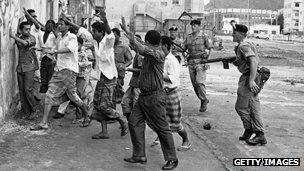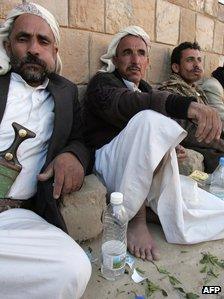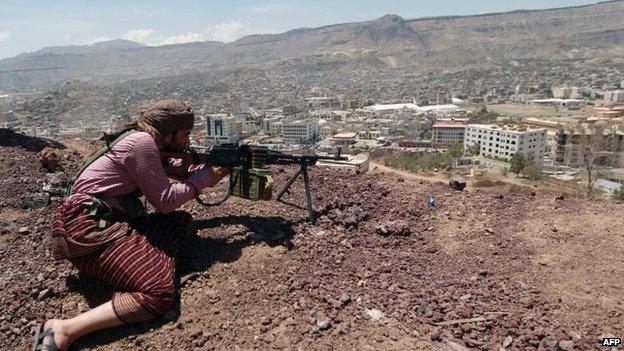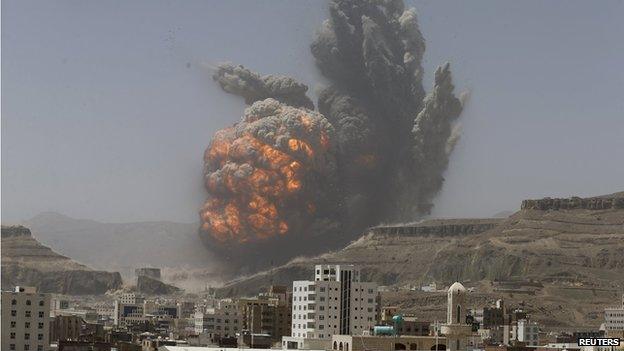Yemen profile - Timeline
- Published
A chronology of key events:
1500s - Ottomans absorb part of Yemen into their empire, but are expelled in the 1600s.
1839 - Aden comes under British rule, and when the Suez Canal opens in 1869 serves as a major refuelling port.
1849 - Ottomans return to north.
1918 - Ottoman Empire dissolves, North Yemen gains independence and is ruled by Imam Yahya.
1948 - Yahya assassinated, but his son Ahmad fights off opponents of feudal rule and succeeds his father.
1962 - Imam Ahmad dies and is succeeded by his son, but army officers seize power and set up the Yemen Arab Republic, sparking civil war between royalists supported by Saudi Arabia and republicans backed by Egypt.
South Yemen formed

British troops intervene in unrest leading up to independence in South Yemen
1967 - Britain withdraws from the south after years of a pro-independence insurgency, and its former territories unite as the People's Republic of Yemen.
1969 - A communist coup renames the south the People's Democratic Republic of Yemen and reorients it towards the Soviet bloc.
1970 - Republican forces triumph in the North Yemen civil war.
1972 - Border clashes between two Yemens; ceasefire brokered by Arab League.
1978 - Ali Abdallah Saleh becomes president of North Yemen.
1979 - Fresh fighting between the two Yemens.
1986 - Thousands die in power struggle in south, which effectively drives the first generation of leaders from office.
Haidar Abu Bakr al-Attas takes over, and begins to work towards unification of the two states.
Uneasy unity

President Saleh (r) was in power from 1990-2012 and outlasted several US presidents, including George Bush (l)
1990 May - The two Yemens unite as the Republic of Yemen with Ali Abdallah Saleh as president, as the Soviet bloc implodes. Tension between former states endures.
1994 May-July - President Saleh declares a state of emergency and dismisses Vice-President Ali Salem al-Beid and other southern officials, who declare the secession of the south before being defeated by the national army.

Southern militia make a bid for separation only a few years after North and South Yemen united
.
1995 - Yemen and Eritrea clash over the disputed Hanish Islands in the Red Sea. International arbitration awarded the bulk of the archipelago to Yemen in 1998.
Al-Qaeda attacks
2000 October - US naval vessel USS Cole damaged in al-Qaeda suicide attack in Aden. Seventeen US personnel killed.
2001 February - Violence in run-up to disputed municipal polls and referendum, which backs extension to presidential term and powers.

Aden is an important sea port and has changed hands many times
2002 February - Yemen expels more than 100 foreign Islamic clerics in crackdown on al-Qaeda.
2002 October - Al-Qaeda attacks and badly damages oil supertanker MV Limburg in Gulf of Aden, killing one and injuring 12 crew members, and costing Yemen dear in lost port revenues.
Houthi insurgency
2004 June-August - Hundreds die as troops battle Shia insurgency led by Hussein al-Houthi in the north.

Yemeni men relax while chewing mildly narcotic qat leaves
2005 March-April - More than 200 people are killed in a resurgence of fighting between government forces and supporters of the slain rebel cleric Hussein al-Houthi.
2007 January-March - Scores are killed or wounded in clashes between security forces and al-Houthi rebels in the north. Rebel leader Abdul-Malik al-Houthi accepts a ceasefire in the summer.
2008 September - Al-Qaeda attack on US embassy in Sanaa kills 12 people.
Demands for reform
2008 November - Police fire warning shots at opposition rally in Sanaa. Demonstrators demand electoral reform and fresh polls.
2009 August - The Yemeni army launches a fresh offensive against Houthi rebels in the northern Saada province. Tens of thousands of people are displaced by the fighting.
2010 September - Thousands flee government offensive against separatists in southern Shabwa province.

Anti-government protesters took to the streets, inspired by successful uprisings in Tunisia and Egypt
2011 September - US-born al-Qaeda leader in Yemen, Anwar al-Awlaki, is killed by US forces.
Unity government
2011 November - President Saleh agrees to hand over power to his deputy, Abdrabbuh Mansour Hadi, after months of protests. A unity government including prime minister from opposition formed.
2012 February - Abdrabbuh Mansour Hadi inaugurated as president after uncontested elections, but is unable to counter al-Qaeda attacks in the capital as the year goes on.

Houthi rebels overran the capital in September 2014
2014 - Presidential panel approves draft federal constitution to accommodate Houthi and southern grievances, but Houthis seize control of most of Sanaa in August and reject the deal.
Foreign intervention
2015 February - Houthis appoint presidential council to replace President Hadi, who flees to his southern stronghold of Aden.
2015 March - Islamic State carries out its first major attacks in Yemen - two suicide bombings targeting Shia mosques in Sanaa, in which 137 people are killed.

Smoke rises from a weapons dump outside Sanaa after being hit in an air strike
Civil war breaks out in earnest as Saudi-led coalition of mainly Gulf Arab states launches air strikes against Houthi targets and imposes naval blockade, in order to halt their advance on Aden.
2015 June - Leader of al-Qaeda in Arabian Peninsula, Nasser al-Wuhayshi, is killed in a US drone strike in Yemen.
2018 January - Southern Yemeni separatists - backed by the United Arab Emirates - seize control of Aden, the main city in the south.
2019 November - Separatists and government sign power-sharing agreement to end conflict in southern Yemen.